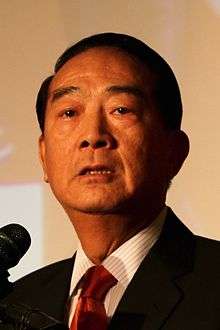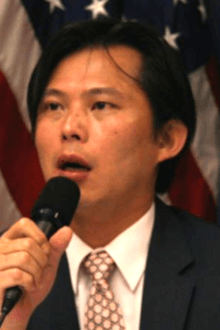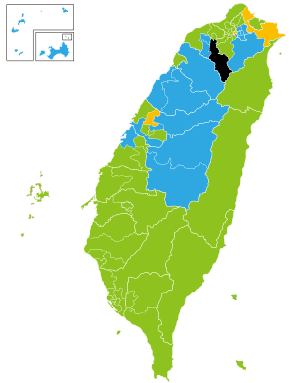Taiwan general election, 2016
| | |||||||||||||||||||||||||||||||||||||||
| |||||||||||||||||||||||||||||||||||||||
| |||||||||||||||||||||||||||||||||||||||
|
| |||||||||||||||||||||||||||||||||||||||
| Leaders in third-level divisions: Tsai-Chen Ticket Chu-Wang Ticket Soong-Hsu Ticket | |||||||||||||||||||||||||||||||||||||||
| |||||||||||||||||||||||||||||||||||||||
General elections were held in Taiwan (officially the Republic of China) on Saturday, 16 January 2016 to elect the 14th President and Vice President of the Republic of China, and all 113 members of the 9th Legislative Yuan.[1] Tsai Ing-wen of the Democratic Progressive Party (DPP) was elected President with 56% of the vote.
Tsai's party, the Democratic Progressive Party, also secured a majority in the legislature, marking the first time that the DPP can govern alone with over a majority. This was unlike the election of 2000, where the DPP won the presidency but did not receive over 50% of the votes. The election marked the first time the Kuomintang lost its majority in the legislature.
The Central Election Commission reported that turnout for the presidential election was 66.27% of voters, the lowest turnout since the office was first directly elected in 1996.[2]
Electoral system
Presidential candidates and vice-presidential running mates are elected on the same ticket, using first-past-the-post. Due to constitutional two-term limits, incumbent president Ma Ying-jeou was ineligible to seek re-election. This was the sixth direct election of the president and vice president by the citizens of Taiwan, which was previously indirectly elected by the National Assembly prior to 1996.
The 113 members of the Legislative Yuan are elected by a supplementary member system, with 73 from geographical constituencies (General) via first-past-the-post, 6 from two 3-member aboriginal constituencies via single non-transferable vote, and 34 from closed list proportional representation (PR) via a national party vote.
All three presidential candidates announced their running mates in November 2015, and for the first time in Taiwanese electoral history, none of the vice presidential candidates shared the same party affiliation as their corresponding presidential candidates.[3] A record-breaking 556 candidates ran for legislative seats.[4][5]
Presidential candidates
Party primaries
According to article 22 of the President and Vice President Election and Recall Act, any political party that garnered 5% of the national vote in the preceding presidential or legislative election, may directly nominate presidential and vice presidential candidates. Parties fulfilling this criteria in this election include the Democratic Progressive Party (DPP), Kuomintang (KMT), People First Party (PFP) and Taiwan Solidarity Union (TSU).[6]
Democratic Progressive Party
According to internal party protocols, presidential primaries are conducted via nationwide opinion polling.[7] Registration was held between 2 and 16 February 2015. Tsai Ing-wen, party chair and former vice-premier, was the only candidate that registered, and thus nationwide opinion polling that were planned to be conducted between 16 and 18 March 2015 were suspended. Tsai was duly nominated by the DPP on 15 April 2015.[8] On 16 November 2015, Tsai Ing-wen announced former health minister Chen Chien-jen as her running mate, who consequently resigned from his post as deputy director of Academia Sinica.
Kuomintang
According to internal party protocols, presidential primaries are conducted via a combination of party member vote with 30% weighting, and nationwide opinion polling with 70% weighting.[9] Registration and petitions were conducted between 20 April to 18 May 2015. Two candidates, including Hung Hsiu-chu, deputy speaker of the Legislative Yuan;[10][11][12] and Yang Chih-liang, former health minister, registered.[13][14] Hung garnered 35,210 signatories in her petition, crossing the eligibility threshold of 15,000 signatories; while Yang garnered only 5,234 signatories, nullifying his candidacy.[15] The party member vote was suspended because Hung was the only eligible candidate. Nationwide opinion polling were conducted from 12 to 13 June 2015; with equal weighting between approval rating and general election polling. Hung garnered an average of 46.204% in the nationwide polling, crossing the eligibility threshold of 30%, and was nominated on 19 July 2015.[16][17]
However, her nomination was revoked by party chair Eric Chu during an extraordinary party convention on 17 October 2015.[18] Chu subsequently replaced Hung as the presidential candidate of the KMT, and announced former labor minister Wang Ju-hsuan as his running mate. Some have alleged that this process was undemocratic.
People First Party
James Soong, party chair of the PFP, announced his presidential bid on 6 August 2015.[19] He announced Minkuotang (MKT) chair and legislator Hsu Hsin-ying as his running mate in November 2015.[20] The PFP–MKT coalition became the first pair of candidates to register for the election on 23 November 2015.[21]
Taiwan Solidarity Union
Although the Taiwan Solidarity Union was eligible to nominate a presidential candidate, party chair Huang Kun-huei publicly announced on 29 June 2015 that the TSU would not do so, in favor of supporting Tsai Ing-wen's presidential bid.[22][23]
Presidential candidate petition
According to article 22 of the President and Vice President Election and Recall Act, presidential and vice presidential candidates not nominated by an eligible political party, may qualify via a petition signed by at least 1.5% of the number of eligible voters during the preceding legislative election: a threshold of 269,709 eligible voters.[6]
- Nori Shih, former legislator and chair of the Democratic Progressive Party, declared his candidature on 21 May 2015.[24] However, due to the failure to collect sufficient signatories on his petition, he withdrew his candidacy on 16 September 2015.[25]
- Hsu Jung-shu, chair of the People Party, and former legislator of the Democratic Progressive Party, declared her candidature on 7 July 2015, and received support from the Taiwan Progressive Party, National Health Service Aliance, and Zhongshan Party.[26] However, despite initially registering at the central election commission, Hsu and her running mate, Hsia Han-ren did not submit their petition, thus nullifying their candidacy.[27]
- Chang Dong-shan, chair of the Grand Union of National Happiness, and running mate, Lin Li-rong, chair of the Positive Party, initially registered at the central election commission, but collected only 72 signatures thus nullifying their candidacy.[27]
- Independent candidates Lan Hsin-kei and Chu Hsu-fang, also registered at the central election commission, but did not submit their petition.[27]
- Music professor Lin You-hsiang and running mate, Hung Mei-chen were endorsed by the Union of Taiwanese Party Chairs, and initially registered at the central election commission, but also failed to submit their petition.[27]
Legislative candidates
| | ||||||||||||||||||||||||||||||||||||||||||||||||||||||||||||||||||||||||||||||||||||||||||||
| ||||||||||||||||||||||||||||||||||||||||||||||||||||||||||||||||||||||||||||||||||||||||||||
| ||||||||||||||||||||||||||||||||||||||||||||||||||||||||||||||||||||||||||||||||||||||||||||
|
| ||||||||||||||||||||||||||||||||||||||||||||||||||||||||||||||||||||||||||||||||||||||||||||
| Results (constituency seats only): DPP KMT NPP Independent | ||||||||||||||||||||||||||||||||||||||||||||||||||||||||||||||||||||||||||||||||||||||||||||
| ||||||||||||||||||||||||||||||||||||||||||||||||||||||||||||||||||||||||||||||||||||||||||||
The two major parties, the Kuomintang and the Democratic Progressive Party, used different strategies when nominating candidates for the Legislative Yuan elections. The Kuomintang nominated a candidate in all but one of the constituency seats.[28] The sole exception was Taipei 2, where they instead supported the New Party candidate. The DPP, on the other hand, developed a cooperation strategy with several minor parties. The DPP agreed to support candidates from these parties in exchange for agreements not to stand in tight races where they might sap DPP votes. These included the New Power Party, the Taiwan Solidarity Union, and the Green-Social Democratic Coalition, as well as several independents.[29] This strategy did not work in Hsinchu, where the NPP and DPP backed separate candidates.[30] A total of 43 female candidates won election to the Legislative Yuan, the most ever to take office.[31]
| 2016 Republic of China legislative election candidates | ||||
|---|---|---|---|---|
| Party | General electorates | Aboriginal electorates | Party list | Total |
| 72 | 5 | 33 | 110 | |
| 60 | 2 | 34 | 96 | |
| 2 | - | 15 | 17 | |
| |
6 | 1 | 16 | 23 |
| - | 1 | 7 | 8 | |
| 13 | 1 | 10 | 24 | |
| |
12 | - | 6 | 18 |
| Green-Social Democratic Coalition[32] | 11 | - | 6 | 17 |
| 14 | - | 10 | 24 | |
| Constitutional Conventions of Taiwan | 12 | - | 6 | 18 |
| 11 | 1 | 5 | 17 | |
| 11 | - | 6 | 17 | |
| Faith And Hope League | 8 | 2 | 6 | 16 |
| Trees Party | 11 | - | 2 | 13 |
| |
9 | 1 | 3 | 13 |
| Peace Pigeon Union Party | 10 | 3 | 13 | |
| 2 | - | 10 | 12 | |
| Taiwan Independence Party | 9 | 1 | 1 | 11 |
| Taiwan Labor Party | 5 | - | - | 5 |
| People's Democratic Front | 2 | - | - | 2 |
| Social Welfare Party | 2 | - | - | 2 |
| Pan-Pacific E.P. Union Party | 2 | - | - | 2 |
| The Motorists' Party of ROC | 1 | - | - | 1 |
| Taiwan Win Party | 1 | - | - | 1 |
| Labor Party | 1 | - | - | 1 |
| Zheng Party | 1 | - | - | 1 |
| Taiwan First Nations Party | 1 | - | - | 1 |
| China Production Party | 1 | - | - | 1 |
| 66 | 6 | - | 72 | |
| Total | 354 | 23 | 179 | 556 |
Opinion polls
Presidential election
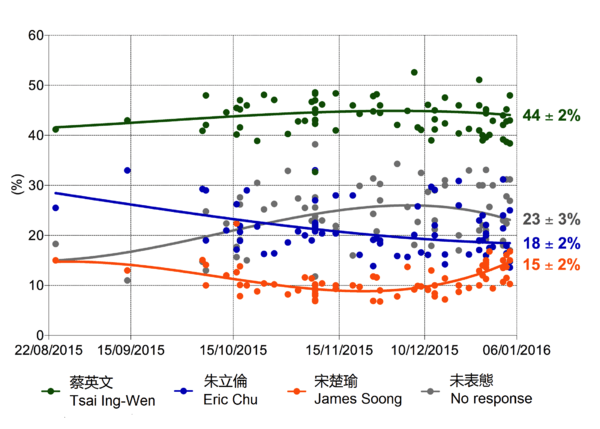
| Nationwide | |||||
|---|---|---|---|---|---|
| Polling organisation | Date(s) administered |
Eric Chu KMT |
Tsai Ing-wen DPP |
James Soong PFP |
Undecided |
| Decision Making Research | 24 Aug 2015 | 25.5% | 41.2% | 15.0% | 18.3% |
| Kuomintang | 14 Sep 2015 | 33% | 43% | 13% | 11% |
| Apple Daily | 6 Oct 2015 | 29.28% | 40.92% | 15.07% | 14.73% |
| Television Broadcasts Satellite | 7 Oct 2015 | 29% | 48% | 10% | 13% |
| Decision Making Research | 7 Oct 2015 | 19.0% | 42.1% | 14.1% | 24.8% |
| Taiwan Indicators Survey Research | 13 Oct 2015 | 21.0% | 44.6% | 12.0% | 22.4% |
| Apple Daily | 16 Oct 2015 | 26.23% | 45.47% | 12.63% | 15.67% |
| Fades Survey Research | 16 Oct 2015 | 17.17% | 40.18% | 22.39% | 17.72% |
| Liberty Times | 17 Oct 2015 | 18.91% | 47.04% | 7.86% | 26.19% |
| Decision Making Research | 17 Oct 2015 | 21.9% | 45.2% | 13.8% | 19.1% |
| Trend Survey Research | 17 Oct 2015 | 20.7% | 41.6% | 10.1% | 27.6% |
| TVBS | 19 Oct 2015 | 29% | 46% | 10% | 15% |
| China Times | 22 Oct 2015 | 21.8% | 38.9% | 8.8% | 30.5% |
| People First Party | 24 Oct 2015 | 17% | 40% | 23% | 20% |
| Taiwan Indicators Survey Research | 12 Nov 2015 | 20.4% | 46.2% | 10.4% | 13% |
| Shih Hsin University Research | 27 Nov 2015 | 18.4% | 44.5% | 6.8% | 30.3% |
| SET News | 6 Dec 2015 | 15.7% | 44.9% | 13.7% | 25.7% |
| TVBS | 13 Dec 2015 | 22% | 45% | 10% | 23% |
| New Taipei City | |||||
| Television Broadcasts Satellite | 15 Oct 2015 | 31% | 47% | 14% | 7% |
| New Taipei City 6th Constituency | |||||
| Next Television | 21 Oct 2015 | 20.9% | 49.8% | 8.1% | 21.2% |
| Hsinchu City | |||||
| Focus Survey Research | 20 Oct 2015 | 21.0% | 46.7% | 12.9% | 19.4% |
| Taichung City | |||||
| Kuomintang | 15 Oct 2015 | 12.8% | 41.4% | 8.4% | 37.4% |
Legislative election

Single and multi member districts
| Source | Date | KMT |
DPP |
TSU |
PFP |
MKT |
NPP |
GP–SD | NP |
FTP |
IND |
Other |
Undecided |
|---|---|---|---|---|---|---|---|---|---|---|---|---|---|
| Trend | February 9, 2015 | 18.5% | 31.2% | - | - | - | - | - | - | - | 14.5% | 1.4% | 34.4% |
| Trend | May 19, 2015 | 19.1% | 25.2% | 2.6% | 3.8% | 0.4% | 3.3% | 2.1% SD:0.3% |
0.9% | - | 13.4% | 3.6% | 25.2% |
| Trend1 | July 12, 2015 | 15.5% | 30.7% | 1.2% | 3.4% | - | - | - | 0.7% | - | 14.0% | - | 29.6% |
| Trend2 | July 16, 2015 | 20.3% | 27.8% | 0.6% | 4.3% | - | - | - | 0.8% | - | 12.9% | 1.2% | 26.9% |
| Trend3 | August 6, 2015 | 19.9% | 25.9% | 0.9% | 4.9% | - | - | - | 1.2% | - | 2.2% | - | 36.7% |
| Taiwan index | September 12, 2015 | 21.4% | 30.9% | 0.1% | 2.5% | - | 0.7% | 0.4% | 0.0% | - | - | 1.5% | 42.3% |
| Apple Daily | September 14, 2015 | 30.29% | 38.17% | 2.11% | 8.12% | 1.33% | 4.53% | - | - | - | - | 15.45% | |
| Trend | September 14, 2015 | 15.9% | 31.2% | 0.4% | 2.1% | 0.8% | 5.9% | 1.4% | - | 0.5% | 11.4% | 2.5% | 27.9% |
| Trend | September 17, 2015 | 18.3% | 29.9% | 1.2% | 2.4% | 0.5% | 5.9% | 1.5% | 0.1% | 0.3% | 3.7% | 1.1% | 35.2% |
| Trend | September 24, 2015 | 18.3% | 32.6% | 1.6% | 5.2% | 0.5% | 5.6% | 2.0% | 0.6% | - | 0.4% | 2.7% | 30.5% |
| Daily | October 16, 2015 | 31.28% | 38.11% | 1.93% | 4.75% | 1.33% | 5.94% | 1.04% | 1.49% | - | - | - | 13.68% |
| TVBS | October 19, 2015 | 30% | 30% | - | 1% | - | 1% | - | - | - | 2% | 1% | 35% |
| Trend | October 24, 2015 | 19.0% | 35.0% | 1.0% | 2.4% | 0.8% | 4.0% | 0.9% | 0.1% | 0.1% | 2.0% | 0.3% | 34.4% |
| Notice: | |||||||||||||
Proportional representation
| Opinion Poll | ||||||||||||
|---|---|---|---|---|---|---|---|---|---|---|---|---|
| Source | Date | People First Party (Republic of China) | Green–Social Democratic coalition | |
||||||||
| Trend | March 14, 2015 | 19.9% | 25.7% | 4.0% | 7.0% | - | - | - | - | - | 43.4% | |
| Trend1 | May 19, 2015 | 26.7% | 33.4% | 4.4% | 6.6% | 0.4% | 3.6% | Green: 3.3% SD: 0.9% |
- | 4.6% | 14.6% | |
| TVBS2 | June 1, 2015 | 24% | 29% | 3% | 4% | 0.8% | 0.4% | Green: 1% SD: 0.1% |
- | 2% | 34% | |
| New Realm3 | July 9, 2015 | 18.67% | 31.67% | 1.61% | 5.14% | - | 3.86% | Green: 0.80% SD: 0.32% |
- | 1.08% | 35.08% | |
| Trend4 | July 12, 2015 | 20.5% | 38.2% | 3.7% | 8.3% | - | - | - | - | - | 20.1% | |
| Tremd5 | July 16, 2015 | 24.6% | 35.6% | 4.1% | 9.2% | - | - | - | - | 0.4% | 16.5% | |
| Decision6 | August 9, 2015 | 24.3% | 30.3% | 1.8% | 6.6% | - | 5.6% | 2.6% | - | - | 27.4% | |
| Freedom Journal | August 26, 2015 | 17.38% | 36.71% | 1.39% | 4.93% | 0.28% | 1.3% | 0.46% | - | 2.42% | 35.13% | |
| Taiwan index7 | September 12, 2015 | 22.1% | 35.1% | 1.9% | 7.2% | 0.0% | 0.3% | Green: 1.3% SD: 0.1% |
- | 2.1% | 29.9% | |
| Trend | September 14, 2015 | 21.5% | 37.6% | 4.1% | 5.6% | 0.8% | 6.8% | 1.8% | 0.5% | 0.9% | 20.4% | |
| Trend | September 17, 2015 | 22.7% | 34.2% | 3.7% | 4.3% | 0.7% | 5.6% | 2.3% | 1.6% | 0.5% | 24.4% | |
| Freedom journal | September 23, 2015 | 17.81% | 34.26% | 1.54% | 3.56% | - | 1.83% | 0.19% | - | 40.82% | ||
| Trend | September 23, 2015 | 19.7% | 34.7% | 3.4% | 6.9% | 0.5% | 7.0% | 1.7% | - | 2.4% | 23.7% | |
| Freedom Journal | October 16, 2015 | 19.01% | 33.17% | 1.65% | 3.2% | 0.39% | 1.75% | 0.10% | - | - | 40.71% | |
| TVBS | October 18, 2015 | 33% | 28% | 3% | 3% | 2% | 5% | 2% | - | 2% | 22% | |
| Trend8 | October 24, 2015 | 21.3% | 37.5% | 3.0% | 7.2% | 0.6% | 4.7% | 2.4% | 0.5% | 0.3% | 22.3% | |
| Shih Hsin University9 | October 31, 2015 | 23.3% | 34% | 2.3% | 4.1% | 0.5% | 3.1% | - | - | - | 30.2% | |
| TVBS | December 13, 2015 | 23% | 27% | 2% | 5% | 2% | 6% | 3% | - | 3% | 25% | |
Notice::
| ||||||||||||
Results
President
Summary of the 16 January 2016 Republic of China presidential election results
| Party | Candidate | Votes | Percentage | |||
|---|---|---|---|---|---|---|
| President | Vice president | |||||
| |
Tsai Ing-wen | Chen Chien-jen | 6,894,744 | 56.12% | | |
| |
Eric Chu | Wang Ju-hsuan | 3,813,365 | 31.04% | | |
| |
James Soong | Hsu Hsin-ying | 1,576,861 | 12.84% | | |
| Total | 12,284,970 | 100% | ||||
County Level Breakdown
| 2016 Presidential Election Breakdown | |||||||||||
|---|---|---|---|---|---|---|---|---|---|---|---|
| County/ City | Registered Voters | Eric Chu (KMT) | Tsai Ing-wen (DPP) | James Soong (PFP) | Invalid Votes | Turnout | Margin of Top 2 Candidates | ||||
| Votes | Percentage | Votes | Percentage | Votes | Percentage | ||||||
| Taipei | 2,175,986 | 546,491 | 37.4905% | 757,383 | 51.9582% | 153,804 | 10.5513% | 22540 | 68.03% | 210,892 | |
| New Taipei | 3,204,367 | 709,374 | 33.3392% | 1,165,888 | 54.7945% | 252,486 | 11.8663% | 26481 | 67.23% | 456,514 | |
| Keelung | 306,548 | 68,357 | 35.2876% | 93,402 | 48.2164% | 31,955 | 16.4960% | 2432 | 63.99% | 25,045 | |
| Yilan County | 369,211 | 59,216 | 25.3817% | 144,798 | 62.0646% | 29,288 | 12.5537% | 3188 | 64.05% | 85,582 | |
| Taoyuan | 1,627,598 | 369,013 | 34.3874% | 547,573 | 51.0270% | 156,518 | 14.5855% | 11898 | 66.66% | 178,560 | |
| Hsinchu County | 412,731 | 94,603 | 35.2817% | 114,023 | 42.5243% | 59,510 | 22.1940% | 3803 | 65.89% | 19,420 | |
| Hsinchu | 328,580 | 71,771 | 32.4235% | 113,386 | 51.2236% | 36,198 | 16.3529% | 3138 | 68.32% | 41,615 | |
| Miaoli County | 448,520 | 107,779 | 37.5500% | 130,461 | 45.4524% | 48,788 | 16.9976% | 3652 | 64.81% | 22,682 | |
| Taichung | 2,138,519 | 430,005 | 29.8181% | 793,281 | 55.0089% | 218,810 | 15.1731% | 19800 | 68.36% | 363,276 | |
| Changhua County | 1,022,962 | 193,117 | 28.7951% | 378,736 | 56.4721% | 98,807 | 14.7328% | 10921 | 66.63% | 185,619 | |
| Nantou County | 415,122 | 83,604 | 32.0843% | 136,104 | 52.2320% | 40,868 | 15.6837% | 3649 | 63.65% | 52,500 | |
| Yunlin County | 566,207 | 86,047 | 24.9321% | 218,842 | 63.4095% | 40,236 | 11.6584% | 4997 | 61.84% | 132,795 | |
| Chiayi County | 430,885 | 65,425 | 23.3822% | 182,913 | 65.3711% | 31,469 | 11.2467% | 4295 | 65.93% | 117,488 | |
| Chiayi | 210,758 | 38,822 | 27.9514% | 83,143 | 59.8621% | 16,926 | 12.1865% | 1492 | 66.61% | 44,321 | |
| Tainan | 1,528,246 | 219,196 | 22.0689% | 670,608 | 67.5175% | 103,432 | 10.4136% | 12457 | 65.81% | 451,412 | |
| Kaohsiung | 2,254,324 | 391,823 | 26.0044% | 955,168 | 63.3923% | 159,765 | 10.6032% | 18117 | 67.64% | 563,345 | |
| Pingtung County | 689,170 | 121,291 | 26.9922% | 285,297 | 63.4902% | 42,768 | 9.5176% | 5595 | 66.01% | 164,006 | |
| Taitung County | 179,547 | 43,581 | 44.6239% | 37,517 | 38.4148% | 16,565 | 16.9614% | 1208 | 55.07% | 6,064 | |
| Hualien County | 267,862 | 73,894 | 47.7219% | 57,198 | 36.9394% | 23,751 | 15.3388% | 2342 | 58.68% | 16,696 | |
| Penghu County | 84,222 | 12,564 | 29.4770% | 21,658 | 50.8129% | 8,401 | 19.7100% | 643 | 51.37% | 9,094 | |
| Kinmen County | 111,386 | 24,327 | 66.0970% | 6,626 | 18.0030% | 5,852 | 15.9000% | 599 | 33.58% | 17,701 | |
| Lienchiang County | 10,240 | 3,065 | 68.5989% | 739 | 16.5398% | 664 | 14.8612% | 85 | 44.46% | 2,326 | |
Source:
| |||||||||||
Legislative Yuan
| ↓ | |||||
| 68 | 1 | 5 | 3 | 1 | 35 |
| Democratic Progressive Party | I | NPP | PFP | N | Kuomintang |
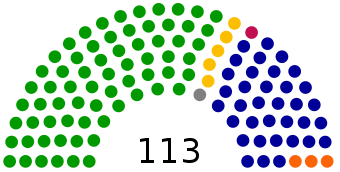
| Party | Constituency | Proportional | Total seats |
+/– | ||||
|---|---|---|---|---|---|---|---|---|
| Votes | % | Seats | Votes | % | Seats | |||
| 5,416,659 | 44.59 | 50 | 5,370,953 | 44.06 | 18 | 68 | ||
| 4,724,366 | 38.89 | 24 | 3,280,949 | 26.91 | 11 | 35 | ||
| 156,212 | 1.29 | 0 | 794,838 | 6.52 | 3 | 3 | ||
| 351,244 | 2.89 | 3 | 744,315 | 6.11 | 2 | 5 | ||
| 75,372 | 0.62 | 0 | 510,074 | 4.18 | 0 | 0 | ||
| Green–Social Democratic Coalition | 203,658 | 1.68 | 0 | 308,106 | 2.53 | 0 | 0 | |
| 97,765 | 0.80 | 0 | 305,675 | 2.51 | 0 | 0 | ||
| Faith and Hope League | 71,101 | 0.59 | 0 | 206,629 | 1.70 | 0 | 0 | |
| 196,180 | 1.61 | 0 | 197,627 | 1.62 | 0 | 0 | ||
| 17,070 | 0.14 | 0 | 87,213 | 0.72 | 0 | 0 | ||
| 27,690 | 0.23 | 1 | 77,672 | 0.64 | 0 | 1 | ||
| Trees Party | 30,224 | 0.25 | 0 | 77,174 | 0.63 | 0 | 0 | |
| 18,812 | 0.15 | 0 | 56,347 | 0.46 | 0 | 0 | ||
| 12,036 | 0.10 | 0 | 51,024 | 0.42 | 0 | 0 | ||
| 18,495 | 0.15 | 0 | 47,988 | 0.39 | 0 | 0 | ||
| Peace Dove Alliance Party | 10,318 | 0.08 | 0 | 30,617 | 0.25 | 0 | 0 | |
| Taiwan Independence Party | 7,809 | 0.06 | 0 | 27,496 | 0.23 | 0 | 0 | |
| Constitutional Conventions of Taiwan | 13,518 | 0.11 | 0 | 15,442 | 0.13 | 0 | 0 | |
| Others | 31,693 | 0.26 | 0 | – | – | 0 | ||
| 668,441 | 5.50 | 1 | – | – | 1 | |||
| Invalid/blank votes | – | – | – | – | – | – | ||
| Total | 79 | 100 | 34 | 113 | 0 | |||
| Registered voters/turnout | – | – | – | – | ||||
| Source: CEC | ||||||||
Chou Tzu-yu flag incident
Chou Tzu-yu, a 16-year-old Taiwanese singer and a member of the South Korean K-pop girl group Twice, attracted attention with her appearance in a South Korean variety show called My Little Television, in which she introduced herself and waved the flag of the Republic of China alongside that of South Korea. Japan's flag was also shown as the other members of the group represented their nationality throughout the show. However, soon after the episode was broadcast it sparked controversy in China when Taiwanese-born China-based singer Huang An accused Chou of being a "pro-Taiwanese independence activist".[37] After the uproar over the issue, the group's record label, JYP Entertainment cancelled all activities of the group in China and released a video where Chou is shown reading an apology, all this the day before the election.[38] She mentioned in part:
"There is only one China. The two shores are one. I feel proud being a Chinese. I, as a Chinese, have hurt the company and netizens’ emotions due to my words and actions during overseas promotions. I feel very, very sorry and guilty."[39]
Nevertheless, many Taiwanese saw her apology as "humiliating and a sign of Taiwan's predicament that Chou had to apologize for expressing her Taiwanese identity and for showing her nation's flag." Tsai in her victory speech also mentioned how it had "angered many Taiwanese people, regardless of their political affiliation." And although it was believed by many that this incident affected the election, contributing to one or two percentage points of Tsai's winning margin,[40] it was thought that the issue probably had a very minor impact on the final outcome since most believed that people would have voted for Tsai anyway. However it is believed that the incident might potentially contribute to Taiwan's desire to become an independent state.[39][41]
See also
References
| Wikimedia Commons has media related to Republic of China legislative election, 2016. |
- ↑ "Presidential, legislative elections set for Jan. 16, 2016". focustaiwan.tw. The Central News Agency. Retrieved 19 March 2015.
- ↑ Tai, Ya-chen; Chen, Chun-hua; Huang, Frances (17 January 2016). "Turnout in presidential race lowest in history". Central News Agency. Archived from the original on 18 January 2016. Retrieved 17 January 2016.
- ↑ Wu, Lilian (18 November 2015). "Running mates of three presidential candidates not from same parties". Central News Agency. Retrieved 18 November 2015.
- ↑ "Number of candidates rises this year". Taipei Times. 6 January 2016. Retrieved 6 January 2016.
- ↑ Tai, Ya-chen; Hsu, Elizabeth (12 January 2016). "Voter list for Taiwan's presidential election surpasses 18.78 million". Central News Agency. Retrieved 12 January 2016.
- 1 2 Presidential and Vice Presidential Election. Central Election Commission, Republic of China
- ↑ 第13任總統提名選舉公告,民主進步黨,2011年3月17日
- ↑ "DPP nominates Tsai as 2016 candidate". taipeitimes.com.
- ↑ 藍6/14公布總統候選人 初選仍納黨員投票,中央廣播電臺
- ↑ "Hung to join KMT presidential primary". taipeitimes.com.
- ↑ Candidates will have 27 days to pick up registration forms. YouTube. 10 April 2015.
- ↑ "KMT's Hung signs up for primary". taipeitimes.com.
- ↑ Former Health Minister Yaung Chih-liang interested in joining presidential primary. YouTube. 23 April 2015.
- ↑ Hung Shiu-chu faces public opinion poll to become KMT presidential nominee. YouTube. 26 May 2015.
- ↑ 國民黨總統初選僅一人通過審核,BBC中文
- ↑ 選戰/洪秀柱跨過防磚門檻 將獲國民黨提名,中央日報
- ↑ "Hung Hsiu-chu officially nominated as KMT's presidential candidate". focustaiwan.tw.
- ↑ "Eric Chu named as KMT's new presidential candidate". focustaiwan.tw.
- ↑ 宋楚瑜宣佈參選2016總統,中央通訊社
- ↑ Hsu, Stacy (19 November 2015). "James Soong chooses Hsu Hsin-ying for ticket". Taipei Times. Retrieved 19 November 2015.
- ↑ Lu, H.H.; Liu, Claudia; Kao, Evelyn (23 November 2015). "PFP to lead in registration for presidential election". Central News Agency. Retrieved 23 November 2015.
- ↑ 台聯、親民黨也有2016門票 參選總統評估中, 蘋果日報, 2015年2月15日
- ↑ 再批「一中同表」黃昆輝:洪擺明是中國代言人, 自由時報, 2015年6月29日
- ↑ "施明德:大家不看好總統連署 我就玩給你看". 蘋果日報.
- ↑ "Shih Ming-te fails to meet threshold, ends candidacy". taipeitimes.com.
- ↑ 許榮淑參選總統 矢志用人生最後力量改造台灣,蘋果即時
- 1 2 3 4 中央社. "中選會:4組獨立參選人連署不足額". 中央社. Retrieved 17 November 2015.
- ↑ 第 09 屆 立法委員選舉(區域) 候選人得票數 (in Chinese), Central Election Commission
- ↑ DPP approves list of candidates outside the party to support, Taipei Times
- ↑ Gerber, Abraham (26 November 2015). "NPP candidate registers for Hsinchu seat race". Taipei Times. Retrieved 16 May 2016.
- ↑ Wen, Kuei-hsiang; Huang, Frances (30 January 2016). "Taiwan's new legislature to have more female lawmakers, become younger". Central News Agency. Archived from the original on 31 January 2016. Retrieved 30 January 2016.
- ↑ 林瑋豐 (17 August 2015). "綠黨社民黨聯盟成立 「淘汰國民黨,制衡民進黨」". 風傳媒. Retrieved 17 August 2015.
- ↑ "黨章 – 中華統一促進黨". china999.org.
- ↑ "自由台灣黨、一邊一國結盟 拼立委選舉". 蘋果日報.
- ↑ RB. "新黨全球資訊網 - [新黨訊] "新黨不選政黨票了嗎?" - 青新論壇 - 新聞公告". np.org.tw.
- ↑
- ↑ "16-year-old K-pop singer waves Taiwan flag, forced to cancel China activities". Shanghaiist. Retrieved 2016-01-22.
- ↑ Politi, Daniel. "Did a 16-Year-Old Pop Star Help Pro-Independence Party Win Taiwan's Election?". Slate. Retrieved 21 January 2016.
- 1 2 Buckley, Chris; Ramzy, Austin (2016-01-16). "Singer's Apology for Waving Taiwan Flag Stirs Backlash of Its Own". The New York Times. ISSN 0362-4331. Retrieved 2016-01-22.
- ↑ "Taiwan election: How a penitent pop star may have helped Tsai win - BBC News". BBC News. Retrieved 2016-01-21.
- ↑ Hsu, Hua (2016-01-20). "Twenty-Somethings in Taiwan and the Country's First Female President". The New Yorker. ISSN 0028-792X. Retrieved 2016-01-22.


